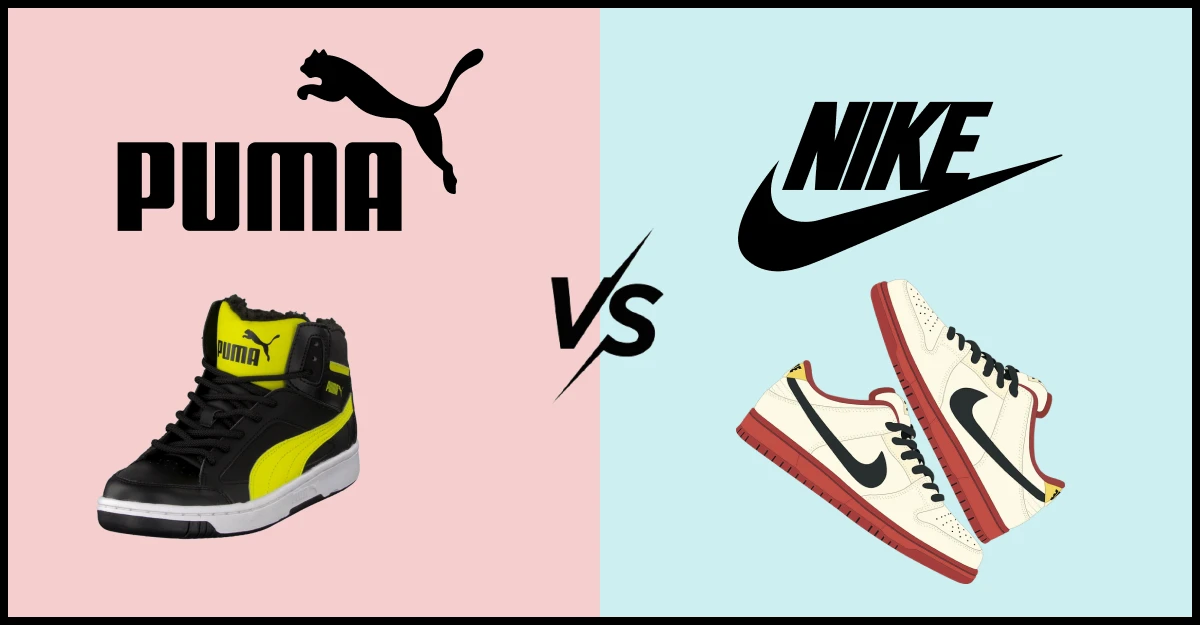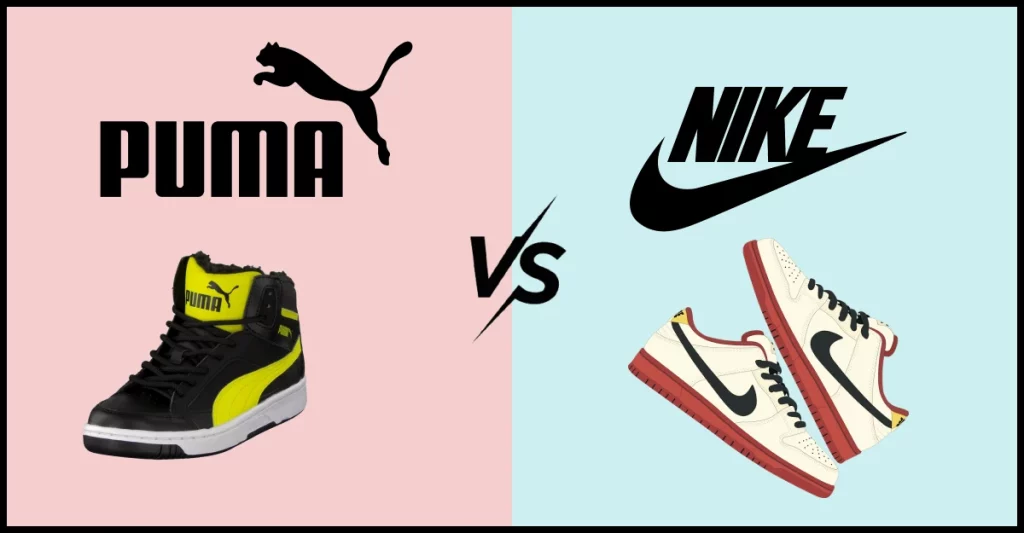In the world of sneakers and sportswear, there’s an epic clash between two giants: Puma vs Nike. These brands have become household names, but the battle continues to determine who the bigger success is and fan favorite. Puma, known for its stylish designs, faces off against Nike, an industry juggernaut with iconic athletes and innovations. As we step into this showdown, we’ll explore their histories, products, and fan followings to find out which one reigns supreme as a favorite and a success story.

So, get ready to lace up your shoes and dive into the rivalry of Puma vs Nike!
(A) Global Business Comparison
Comparing the global business of Puma and Nike reveals significant differences. For a quick overview, please refer to the table below-
| Particulars | Puma | Nike |
| Brand Value | $4 billion | $50 billion |
| Number of Stores Worldwide | 1,948 | 1,096 |
| Market Share (2023) | 8-9% | 65.9% |
| Total Revenue Earned (2022) | EUR 8.465 billion | $46.71 billion |
| Market Capitalization (2023) | EUR 9.26 billion | $147.85 billion |
| Presence | 120 countries | 170 countries |
Nike’s brand value is $50 billion, vastly surpassing Puma’s $4 billion, showcasing Nike’s global dominance. Puma has 1,948 stores worldwide, while Nike has 1,096. In terms of market share in 2023, Nike leads at 65.9%, with Puma at 8-9%. Nike’s 2022 revenue was $46.71 billion, while Puma’s was EUR 8.465 billion. Market capitalization in 2023 sees Nike at $147.85 billion and Puma at EUR 9.26 billion. Nike is present in 170 countries, compared to Puma’s presence in 120.
(B) Market share comparison in leading countries
Puma and Nike have distinct regional market strengths. Before diving into details, refer to the table given below for a quick overview-
| Regions | Puma | Nike |
| EMEA (Europe, Middle East, and Africa) | 36.8% | 28% |
| North America | 43.5% (including Latin America) | 44% |
| Greater China | – | 15% |
| Asia Pacific | 19.7% | 13% |
| Latin America | – |
In EMEA, Puma leads with 36.8%, while Nike has 28%. North America is closely contested, with Puma at 43.5% (including Latin America) and Nike at 44%. In Greater China, Nike dominates with 15%, while Puma has a limited presence. In the Asia Pacific, Puma leads with 19.7% versus Nike’s 13%.
Notably, Latin America data for Nike is not available, complicating the assessment. These regional disparities highlight Puma and Nike’s diverse global strategies and strengths.
(C) Puma vs Nike: Key Differences
Let’s look at the major differences in the battle of Puma and Nike-
| Particulars | Puma | Nike |
| Founding Year | 1948 | 1964 |
| Founders | Rudolf Dassler | Bill Bowerman Phil Knight |
| Headquarters | Herzogenaurach, Germany | Washington, USA |
| Brand Slogan | “Forever Faster” | “Just Do It” |
| Primary Focus | Sportswear and Lifestyle Fashion | Performance Sportswear and Athleisure |
| Signature Products | Puma Suede, Clyde, RS Collection | Nike Air Max, Air Jordan, SB Dunk |
| Brand Associations | Formula 1, NFL | NBA, NFL, Cristiano Ronaldo, Serena Williams |
| Market Position | Fusion of sports and fashion | Dominant presence in performance sportswear |
| Target Audience | Lifestyle, streetwear consumers | Athletes, sports enthusiasts, casual wear |
| Sustainability Efforts | 10FOR25″ sustainability plan | Sustainable Materials and Initiatives |
| Notable Collaborations | Rihanna, Selena Gomez | Off-White, Travis Scott, Virgil Abloh |
| Global Presence | 120 Countries | 170 Countries |
(D) Puma Specialties and Drawbacks
Puma’s strengths lie in its ability to combine sport and fashion seamlessly, iconic classics, and successful celebrity collaborations. However, it faces challenges in terms of market share, a narrower sports focus, occasional quality concerns, and competitive pricing. These factors highlight the complex landscape of the sportswear industry where Puma has carved a unique niche.
Let’s look at the specialties and drawbacks of Puma-
| Puma’s Specialties | Drawbacks |
| Fashion Fusion | Limited Sports Focus |
| Iconic Classics | Fewer Athletic Endorsements |
| Celebrity Collaborations | Small Market Share |
| Motorsport Heritage | Quality Concerns |
| Sustainability Initiatives | Pricing |
(D.1) Puma Specialties
The special features of Puma are described below-
Fashion Fusion
Puma excels in seamlessly blending sports and fashion, creating stylish sportswear that appeals to both athletes and those looking for trendy streetwear. This unique fusion gives Puma a distinct edge in the fashion-forward market.
Iconic Classics
The Puma Suede and Clyde sneakers are iconic classics known for their sleek design, comfort, and versatility. These timeless shoes have garnered a dedicated following among sneaker enthusiasts and fashion-conscious consumers.
Celebrity Collaborations
Puma has successfully collaborated with celebrities such as Rihanna, Selena Gomez, and Jay-Z. These partnerships have not only elevated the brand’s visibility but also brought fresh, appealing designs to their collections.
Motorsport Heritage
Puma’s strong association with motorsport, including sponsorships of Formula 1 teams, has established its credibility in this niche market. Motorsport-inspired apparel and footwear are coveted by racing enthusiasts.
Sustainability Initiatives
Puma’s “10FOR25” sustainability plan showcases its commitment to environmental responsibility. The brand aims to reduce its carbon footprint and waste, appealing to consumers increasingly concerned about eco-friendly practices.
(D.2) Puma Drawbacks
Here are a few limitations of Puma-
High Competition: Who is Puma’s biggest competitor?
Puma faces intense competition from other sportswear giants, particularly Nike and Adidas. Maintaining market share and innovation supremacy in this competitive landscape is an ongoing challenge.
Limited Sports Focus
Puma’s sports offerings, while stylish, may not match the performance capabilities and depth of product lines offered by competitors like Nike or Adidas. Serious athletes may prefer other brands for sport-specific gear.
Fewer Athletic Endorsement
While Puma has signed notable athletes and teams, its roster of endorsements is generally smaller and less high-profile compared to industry leaders like Nike.
Smaller Market Share
Puma holds a smaller global market share compared to sportswear giants like Nike and Adidas. This can affect its ability to compete on a larger scale.
Quality Concerns
Some consumers have reported issues with durability and quality control for certain Puma products, which can affect brand reliability and trust.
Pricing
Although generally more affordable than Adidas and Nike, Puma products can still be relatively expensive, which may limit accessibility for budget-conscious shoppers.
(E) Nike Specialties and Drawbacks
Nike’s strengths lie in its relentless pursuit of performance innovation, athlete endorsements, iconic footwear, global dominance, and efforts toward social responsibility. However, challenges such as premium pricing, past controversies, competition, brand overexposure, and sustainability pressures must be addressed as part of the brand’s ongoing journey in the sportswear industry.
Let’s look at the specialties and drawbacks of Nike-
| Nike’s Specialties | Drawbacks |
| Performance Innovation | Premium Pricing |
| Athlete Endorsements | Controversies |
| Iconic Footwear | High Competition |
| Global Dominance | Brand Overexposure |
| Social Responsibility | Pressure for sustainability |
(E.1) Nike’s Specialties
The following features make Nike a special brand in the sportswear segment-
Performance Innovation
Nike is renowned for its relentless pursuit of innovation in sportswear, creating cutting-edge technologies like Nike Air, Flyknit, and Dri-FIT. These innovations enhance performance and comfort for athletes across various sports.
Athlete Endorsements
Nike boasts a vast roster of top-tier athletes, including LeBron James, Serena Williams, and Cristiano Ronaldo. These endorsements enhance the brand’s credibility and influence in the sports world.
Iconic Footwear
Nike’s iconic shoe lines like Air Max, Air Jordan, and SB Dunk have achieved legendary status among sneaker enthusiasts, transcending sports and becoming cultural icons.
Global Dominance
Nike holds a dominant position in the global sportswear market, with a vast retail presence, strong brand recognition, and a massive consumer base.
Social Responsibility
Nike has made strides in addressing social and environmental concerns. Initiatives like the “Move to Zero” plan aim to reduce the brand’s environmental impact, appealing to conscious consumers.
(E.2) Nike’s Drawbacks
Here are the few drawbacks of Nike that immensely impact its sales-
Premium Pricing
Nike’s commitment to innovation often results in premium pricing. Some of its high-performance products can be relatively expensive, making them less accessible to budget-conscious consumers.
Controversies
Nike has faced controversies related to labor practices in the past, particularly concerning overseas manufacturing. Such issues have led to criticism and negative publicity.
Competition
Nike faces fierce competition from other sportswear giants like Adidas and Under Armour. Staying ahead in a crowded market requires constant innovation and marketing efforts.
Brand Overexposure
The sheer ubiquity of the Nike brand, while a sign of success, can also lead to brand fatigue among some consumers, who may seek more niche or exclusive alternatives.
Pressure for sustainability
Despite sustainability efforts, Nike is under increasing pressure to further reduce its environmental impact and address ethical concerns related to its supply chain.
(F) Which is more popular Puma or Nike?
Nike is generally more popular than Puma. According to the Global Top 100 Brands ranked by customers, Nike is ranked #7, while there is no specific ranking for Puma mentioned in the search results. Additionally, Nike has a higher market capitalization at $222.95 billion, indicating its larger presence in the market compared to Puma.

However, popularity can also vary among different regions or demographics. Each brand has its own unique design, style, and target audience. Puma is known for being more affordable compared to Nike, but Nike is often perceived as having higher quality products. Ultimately, the preference between the two brands depends on individual preferences and needs.
Note: We have also covered a comparative analysis of Nike and Adidas. If you are interested in knowing which one is better and ruling the market, then go through the article “Nike vs Adidas.”
(G) Final Verdict
In the spirited contest of Puma vs. Nike, defining a clear winner as the bigger success and favorite proves elusive. Both brands have distinct strengths, drawing fervent followings in different ways. Puma’s fusion of fashion and sportswear, iconic classics, and celebrity collaborations resonate with style-conscious consumers.
Meanwhile, Nike’s relentless innovation, athlete endorsements, and iconic sneaker lines make it a powerhouse in the athletic world. The preference between Puma and Nike hinges on personal taste, lifestyle, and sporting needs.
Ultimately, in this dynamic market, both brands triumph by offering diversity and catering to a wide range of consumer preferences.

